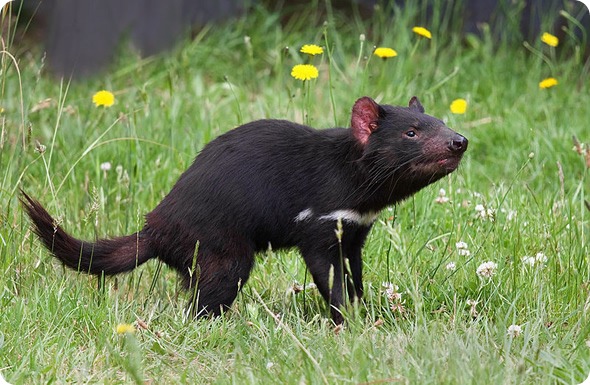Researchers, including those from Wellcome Trust Sanger Institute near Cambridge, have sequenced the genome of a facial cancer that is threatening the existence of the Tasmanian devil.
The team of researchers has worked to piece together the genome of a fatal cancer that is sweeping through Tasmanian devils. Their work gives important clues to how the tumor evades detection by the devils' immune system and shows - for the first time - that the devil in which the tumor originated was a female. The devil disease, which causes tumors to the head and face, is fatal, usually within six to nine months of the onset of symptoms.
Tasmanian devil facial tumor disease was first seen on the island of Tasmania in 1996 and has spread widely since. As a result, the Tasmanian devil is at risk of extinction, and is on the red list of the International Union for the Conservation of Nature and Natural Resources.
The cancer is a facial tumor and is one of only two naturally occurring transmissible cancers known (the other affects dogs). Transmissible cancers pass between animals by the physical transfer of cancer cells. Because the cancer is spread by the physical exchange of cancer cells, all tumors killing devils today are descended from the same single cancer, originating in a single devil.
Thus the researchers termed the cancer genome “immortal devil” and sequenced the genomes of a healthy male and female devil and the genomes of tumors taken from two devils from the north and south of Tasmania. By comparing the cancer genomes with the normal genomes, they were able to work out which mutations arose as the cancer developed and which were normal genetic variants present in the genome of the original devil.
They found more than 17 000 genetic mutations in the cancer genome - fewer than expected. “Our findings indicate that it's a relatively stable cancer, one whose genome has remained fairly intact in spite of the fact that it's transmissible and it has passed through a number of individuals,” says Dr Elizabeth Murchison, lead author on the paper. “This shows that a cancer does not need to have an incredibly unstable genome in order to become transmissible.”
Team leader Dr Janine Deakin of the Research School of Biology at the Australian National University said on Friday the devil tumor had changed very little over the last 16 years. “That's really unusual for cancers, because usually for human cancers evolution is rapid and the tumor will be completely different between the original tumor and its metastases,” Dr Deakin said in a statement. “In this work we confirmed that the devil tumor is genetically very stable.”
“In humans, you are usually working with a rapidly evolving cancer and it's hard to identify the important things because it's all happening so fast,” Dr Deakin said. “The devil is going to be a good model for looking at some human cancers because it is so stable - with everything happening slower we have a better chance of finding those things out.”
The researchers identified 458 genes with mutations that change the coding regions (the parts that contain the instructions to make proteins), including mutations in two genes that are frequently mutated in human cancers. The researchers are now planning to build on this work and explore further how this cancer evades detection by the devil immune system.
“We still don't know how the cancer is able to spread without eliciting an immune response,” says Elizabeth. “We'd like to understand this more, ultimately so that we can work to develop vaccines and therapies that could help with conservation.”
“Cancers that transmit through populations are obviously incredibly rare, but we should use the Tasmanian devil example to understand the process to be prepared in the extremely unlikely event that such an epidemic ever occurs in humans,” says Professor Mike Stratton, senior author and Director of the Wellcome Trust Sanger Institute.
“Having the genome should also allow us to identify cancer-causing genes, and hopefully find drugs that may help to control the disease,” says Katherine Belov, an authority on Tasmanian devils at the University of Sydney, who was not involved in the study. “There is some early evidence that the disease is behaving differently in devils in north-west Tasmanian populations,” says Belov. “The disease there is affecting fewer devils and taking longer to kill them off, and at this stage we don't know whether that's because the devils there are more resistant, or the tumor strains are different, or both,” she says. “Genomics will help us to solve this.”
The research was published in the scientific journal PLoS Genetics.